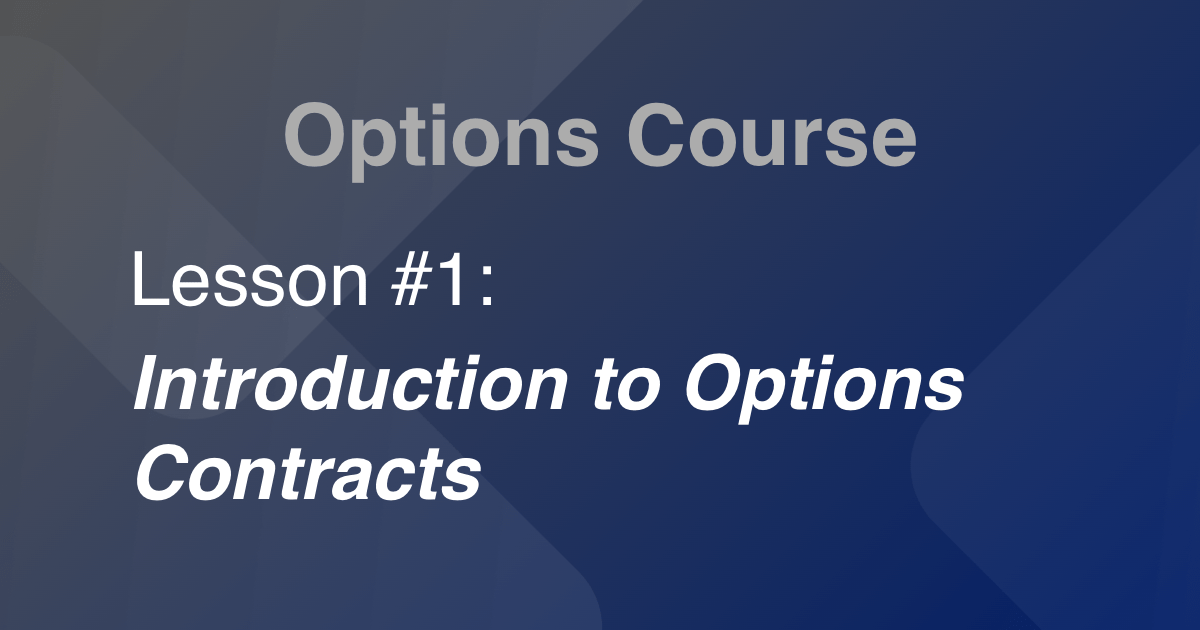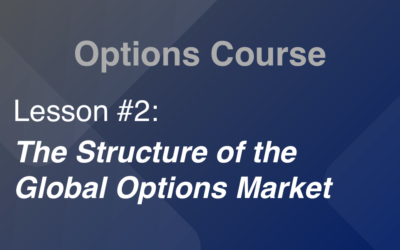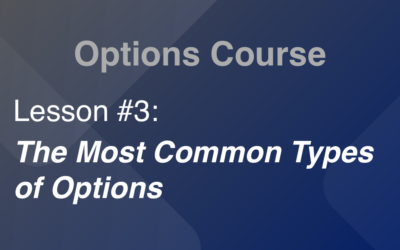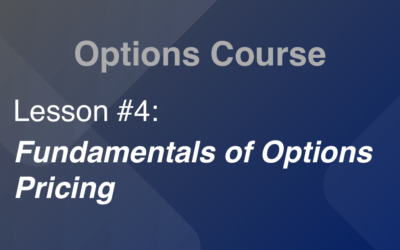In this lesson we provide a brief introduction to options contracts. First, we discuss what an option contract actually is. We then move on to an introduction to some basic characteristics of options before providing a couple of simple examples of options. Lastly, we introduce the important concept of option moneyness.
This reading is part of our introductory options course. Please check out the full overview of lessons here.
1. What are Options Contracts?
An option is a financial derivative contract that gives a party the right to buy or sell an underlying at a fixed price by a certain time in the future. The option buyer is the party who holds the right, whereas the option seller is the one who grants it.
There are two types of options, a call and a put. A call option gives you the right to buy the underlying, while a put option gives you the right to sell it. A given option contract is either a call, allowing the right to buy, or a put, allowing the right to sell, but not both, with the exception of some advanced types of options. The option buyer, also known as the long or option holder, holds the right to buy or sell, which is granted by the option seller, also known as the short or option writer.
The option buyer pays the seller a sum of money known as the option price, option premium, or simply the premium to obtain this right. This money is paid when the option contract is initiated.
2. Basic Characteristics of Options
The exercise price, often known as the strike price or strike, is the preset price at which the option holder can purchase or sell the underlying. Exercise or exercising the option refers to the act of using this right to buy or sell the underlying. An option, like all derivative contracts, has an expiration date, which gives rise to the term “time to expiration.” When an option’s expiration date approaches, it simply expires if it is not used.
Whether the option is a call or a put determines what happens at exercise. When a buyer exercises a call, he pays the exercise price and receives the underlying or a cash settlement in exchange. The seller is on the other side of the transaction, receiving the exercise price from the buyer and either delivering the underlying or paying an equivalent cash settlement. When a buyer exercises a put, he provides the stock and receives the exercise price or a cash settlement in exchange. As a result, the seller receives the underlying and must pay the exercise price or the cash settlement equivalent.
Cash settlement is possible, as stated in the preceding paragraph. When an option holder exercises a call, the seller pays the difference between the underlying’s market value and the exercise price in cash. If a put option is exercised, the difference between the exercise price and the market value of the underlying is paid in cash to the option holder.
There are two primary exercise styles associated with options. One type of option has European-style exercise, which implies that the option can only be exercised on its expiration day. Expiration may occur on that day in some situations, whereas exercise may occur only after the option has expired in others. In either scenario, this type of option is referred to as a European option. The other style of exercise is American-style exercise. An American option is a type of option that can be exercised on any day up to and including the expiration date.
Option contracts specify a designated number of units of the underlying. For exchange-listed, standardized options, the exchange establishes all terms of the option except for the price which is negotiated between the two parties. In the case of an over-the-counter option, the two parties negotiate each of the terms. In an over-the-counter option—one created off of an exchange by any two parties who agree to trade—the buyer is subject to the possibility of the writer defaulting.
The writer must either deliver the stock or pay cash if the buyer exercises a call, or pay for the shares or pay cash if the buyer exercises a put. If the writer is unable to do so due to financial constraints, the option holder will suffer a credit loss. The seller is not exposed to credit risk because the option holder paid the full price up front and is not obligated to do anything else. In forward contracts, for example, credit risk is bilateral (the long carries the risk of the short defaulting, and the short bears the risk of the long defaulting), whereas credit risk in options is unilateral. Because only the seller can default, only the buyer is exposed to credit risk (for exchange-listed options, the clearinghouse guarantees payment to the buyer).
3. Examples of Options
Consider some call and put options on Microsoft (MSFT). The date is 15 June and Microsoft is selling for $163. The below Exhibit gives information on the closing prices of four options, ones expiring in July and October and ones with exercise prices of 150 and 175. The July options expire on 15 July and the October options expire on 15 October. These are referred to as the July 150 calls, July 175 calls, October 150 calls, and October 175 calls with similar terminology for the puts. These particular options are American style.
Consider the July 150 call. This option allows the holder to buy MSFT at a price of $150 a share any time until and including 15 July. To obtain this option, one would pay a price of $17. Therefore, the seller receives $17 on 15 June and must be prepared to sell MSFT to the buyer for $150 during the period through 15 July. Although MSFT is currently trading above $150 per share, the option holder has no reason to execute the option at this time.1 To justify buying the call, the buyer must believe that the price of MSFT will rise before the option expires. The call seller must believe that MSFT’s price will not increase sufficiently before the option expires.
Alternatively, the option buyer might buy a call expiring in July that allows him to buy MSFT for $175. Because this exercise price is higher than the $150 exercise price, the option is significantly less expensive, selling for only $4. Because the stock has a larger hurdle to overcome, the July 175 call is less likely to be exercised, resulting in a lower price. A buyer is unwilling to spend as much, and a seller is willing to accept less for an option that is less likely to be exercised.
The option buyer could also choose to purchase an October call instead of a July call. For any exercise price, however, the October calls would be more expensive than the July calls because they allow a longer period for the stock to make the move that the buyer is anticipating. Due to the fact that October options are more likely to be exercised than July options, a buyer would be willing to pay more for the October calls, and the seller would demand more.
Exhibit: Closing Prices of Selected Options on MSFT, 15 June
| Exercise Price | July Calls | October Calls | July Puts | October Puts |
|---|---|---|---|---|
| 150 | 17 | 24 | 3 | 10 |
| 175 | 4 | 13 | 15 | 23 |
Suppose the buyer believes the stock price will fall. In that situation, he might consider purchasing a put. Consider the October 175 put, which would set you back $23 if you bought it. This option would allow him to sell MSFT for $175 at any moment between now and October 15th. He has no motive to execute the option at this time because doing so would entail buying the option for $23 and selling a stock worth $163 for $175. In reality, the option holder would give up $186 (the cost of the option of $23 plus the value of the stock of $163) in exchange for only $175. The buyer of a put obviously must be anticipating that the stock will decline before the expiration date.
If he wanted a cheaper alternative to the October 175 put, he could purchase the October 150 put for $10, but he’d only be able to sell the shares for $150. Because the stock price must fall below a lower hurdle, the October 150 put is less likely to be exercised than the October 175. As a result, the buyer is not willing to pay as much and the seller is willing to accept a lower price.
Buying a July put instead of an October put at the same exercise price would be substantially cheaper, but it would give the stock less time to complete the necessary downward move for the transaction to be worthwhile for the buyer. Because the buyer is not willing to spend as much and the seller is willing to accept less because the option is less likely to be exercised, the July put is less expensive than the October put.
In observing these option prices, we have discovered some key principles involved in pricing options.
Call options have a lower premium the higher the exercise price.
Put options have a lower premium the lower the exercise price.
Both call and put options are cheaper the shorter the time to expiration.2
4. Moneyness of an Option
The moneyness of an option, which relates to the relationship between the underlying price and the exercise price, is an important concept in understanding options. The expressions in-the-money, out-of-the-money, and at-the-money are all used in this context.
The concept is explained in the Exhibit below with examples from the MSFT options. In-the-money options are those in which exercising the option results in a cash inflow that is greater than the cash outflow. As a result, calls are in-the-money when the underlying value exceeds the exercise price. Conversely, puts are in-the-money when the underlying value is below the exercise price. There are no at-the-money MSFT options in our scenario, because the stock value must equal the exercise price. However, an at-the-money option can effectively be seen as an out-of-the-money option because its exercise would not generate more money than is paid out.
As explained above, one would not necessarily exercise an in-the-money option, but one would never exercise an out-of-the-money option.
Exhibit: Moneyness of an Option
| In-the-Money | Out-of-the-Money |
|---|
| Option | Justification | Option | Justification |
|---|---|---|---|
| July 150 Call | 163 > 150 | July 175 Call | 163 < 175 |
| October 150 Call | 163 > 150 | October 175 Call | 163 < 175 |
| July 175 Put | 175 > 163 | July 150 Put | 150 < 163 |
| October 175 Put | 175 > 163 | October 150 Put | 150 < 163 |
Next Lesson:
The Structure of the Global Options Market >>>
- The option was purchased for $17. The option holder would have to pay $150 for the shares now, which is only worth $163. As a result, he would have effectively paid $167 for a stock worth $163 (the cost of the option of $17 plus the exercise price of $150). Even if he had previously purchased the option at a lower cost, the current option price of $17 represents the opportunity cost of exercising the option—that is, he may always sell the option for $17. As a result, if he chose to exercise the option, he would be foregoing the $17 he could get if he sold it.[↩]
- There is an exception to the rule that put options are cheaper the shorter the time to expiration. This statement is always true for American options but not always for European options.[↩]






0 Comments